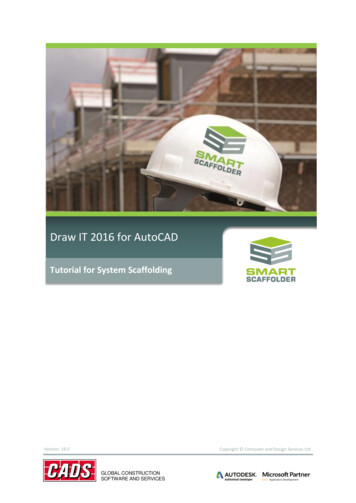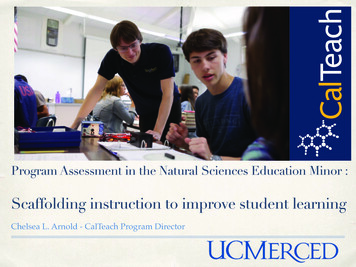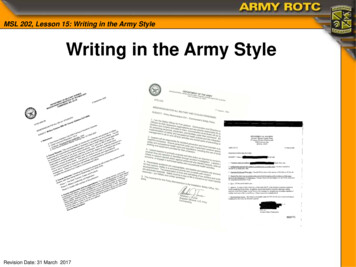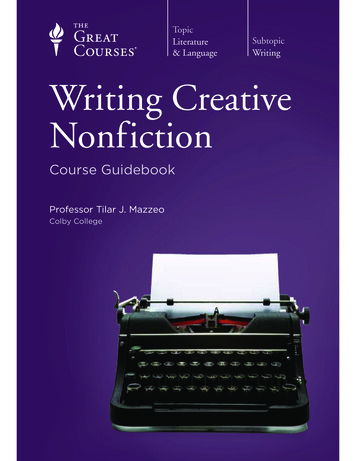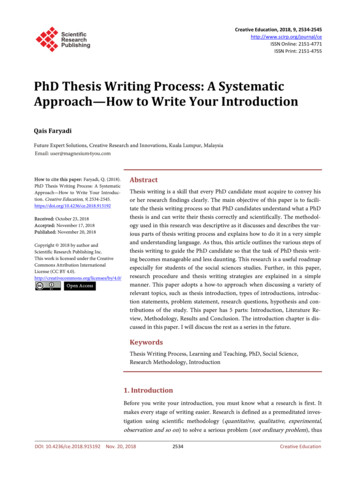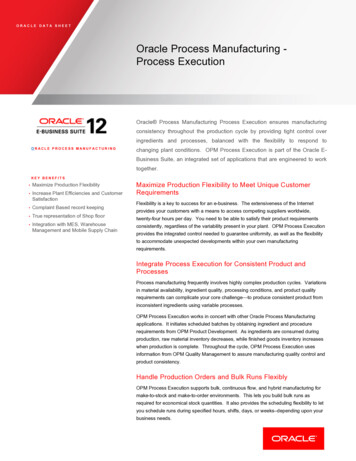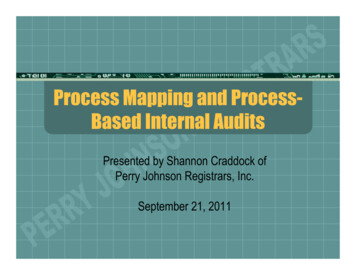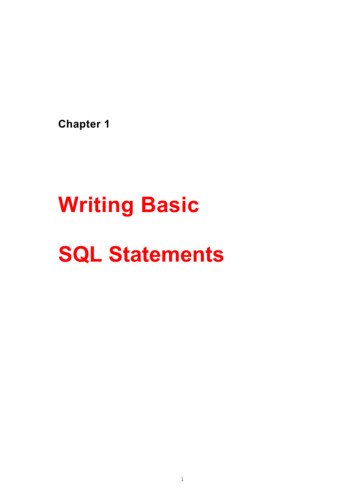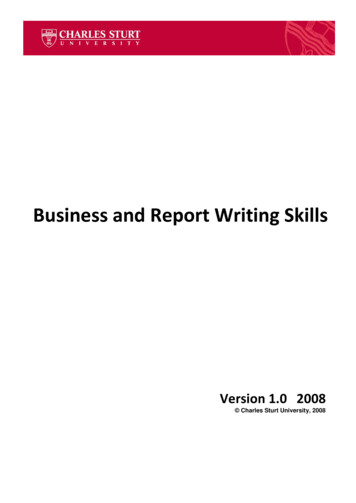
Transcription
Training & Technical Assistance CenterP.O. Box 8795Williamsburg, VA 23187-8795The Writing Process: AScaffolding ApproachConsiderations PacketFor more information contact:E-mail:ttacwm@wm.eduPhone:757-221-6000 or 800-323-4489Website: http://education.wm.edu/centers/ttac/index.php
The Writing Process: A Scaffolding ApproachDifferentiating writing instruction for a population of diverse learners may sound difficult; but, itdoes not have to be. Scaffolding is one process that allows teachers to organize a writing activitysystematically to meet the needs of all students. This Considerations Packet introduces ascaffolding approach for a typical six-step writing process that can be modified for almost all gradeand ability levels. Additionally, a sample outline for a descriptive writing activity is provided, aswell as suggestions for writing assessment.Beginning to write, you discover what you have to write about. Kit ReedThe Writing ProcessAs with most teaching and learning techniques, it is important to stress consistency in the writingprocess. Establishing a structured approach that is used for every assigned paper is one way tocreate independent writers and ensure generalization of writing skills.A typical writing process consists of steps. Essentially, it is a method used by teachers to leadstudents from random thoughts to a cohesive, written paper. The basic writing process for thepurpose of this packet includes six steps: brainstorming, outline, rough draft, evaluation, final draft,and publishing.Step 1: BrainstormingBrainstorming suggests a haphazard approach to getting thoughts out of the mind and ontosome type of canvas (e.g., chalkboard, overhead, worksheet). Brainstorming can be andshould be guided by the teacher before students are expected to complete this stepindependently. Graphic organizers, such as a web, map, or frame (Ellis, 2000), arerelatively simple devices that can be used to guide this step.Step 2: OutlineThe outline is used to further organize the thoughts revealed in the Brainstorming step.Teacher-generated and later, co-constructed outlines allow students to visualize the differenttopics and paragraphs within the paper.Step 3: Rough DraftConsiderations: The Writing Process: A Scaffolding ApproachT/TAC W&MUpdated 20152
The transition between outline and rough draft is a relatively small step. A solid outlinevisually identifies the sections of the paper so students can transfer the isolated sentences ordetails into flowing paragraphs.Step 4: EvaluationThe evaluation step includes peer and teacher proofing as well as editing. The teacherprovides a list of questions and instructions that is both general (e.g., spelling, grammar) andspecific (e.g., number of paragraphs, sentence length) that guides the evaluator through thisstage of the process. The writer uses the evaluation feedback to make corrections asnecessary.Step 5: Final DraftAfter the suggestions from the evaluator(s) are considered, the student proceeds to the finaldraft. The final draft is usually a handwritten copy that the student submits for a grade.(Note: It may be necessary to require some or all students to review the corrections with theteacher before proceeding to this stage.)Step 6: PublishingThis is considered an optional stage for the writing process. The students should beencouraged to produce some type of creative product that enhances the written work. Thisstep incorporates technology, art, music, drama, and the like into the lesson and may providean incentive for completing the writing task.What the child is able to do in collaboration today,he will be able to do independently tomorrow. L. S. VygotskyScaffoldingScaffolding allows the teacher to help students transition from assisted tasks to independentperformances (Bliss & Askew, 1996; Bodrova & Leong, 1998; Palincsar, 1998). It is a step-by-stepprocess that provides the learner with sufficient guidance until the process is learned, and thengradually removes the supports in order to transfer the responsibility for completing the task to thestudent.For scaffolding to be successful, a foundation or organized procedure must first be developed. Theteacher must provide students with the optimal amount of support necessary to complete the task,and then progressively decrease the level of assistance until the student becomes capable ofcompleting the activity independently (Bodrova & Leong, 1998; Elicker, 1995).Considerations: The Writing Process: A Scaffolding ApproachT/TAC W&MUpdated 20153
The highest stake of all is our ability to help children realize their full potential. Samuel J. MeiselsPractical ApplicationJoan Turner, a general 8th-grade literature and writing teacher for Norfolk Public Schools,originally presented the following writing lesson. It has been adapted and modified to accommodatethe diverse needs of students in a co-taught setting and illustrates the scaffolding approach. Thisexample serves as a starting point. Teachers are encouraged to incorporate the scaffoldingapproach with other writing assignments based on their students’ interests and experiences.Lesson:Descriptive Writing AssignmentTopic:PopcornPreparation:Microwave a bag (or two) of popcorn in class for the students to observe. Focus theirattention to the five senses: sight, sound, smell, taste and touch.Steps of the Writing Process:Step 1: BrainstormingUsing a frame or web graphic organizer (see figures), the teacher elicits details for each ofthe five senses as they pertain to the student experiences. The framing organizer (Ellis,2000) offers several different formats for framing information, which can be modified fordifferent grade levels or ability levels within a classroom. After describing what they haveseen, heard, smelled, tasted, and touched, the students number the descriptions to organizetheir thoughts. The frame allows students to order their thoughts by placing numbers in thesmaller circles to the right of the key ideas.Webbing is a common graphic organizer technique used to show the “central topic” (center)and the ideas that support that topic (smaller circles). The lines represent the details thatstudents use to describe each of the five senses.Step 2: OutlineThe language used and the amount of information contained in the outline greatly dependson the students’ abilities and grade level. For example, older or more advanced students maybe able to complete a generic outline. Additionally, the standards for the outline may varyamong students. Some may need to finish the outline with complete sentences, while othersare capable of supplying words or phrases. The transition to step 3 (rough draft) is muchsmoother, however, when students use complete sentences. A sample outline is provided toillustrate Step 2.Considerations: The Writing Process: A Scaffolding ApproachT/TAC W&MUpdated 20154
Step 3: Rough DraftThe rough draft is the step where the students begin to compile all of the details intocohesive, flowing thoughts. Encourage students to use transition words and vary sentenceformats and lengths. Many students get overwhelmed at this point and worry about spellingand grammar. Continuously remind them that this is NOT the final paper and mistakes arepart of learning. A word bank may be helpful for commonly misspelled words or specificwords used in the current paper.Framing OrganizerWhat is the topic of your paper?What do you remember?SightSoundSmellTasteTouchKey Ideas? What’s important about this activity?Key Ideas? What’s important about this activity?Considerations: The Writing Process: A Scaffolding ApproachT/TAC W&MUpdated 20155Adapted from Ellis, 2000
Webbing ions: The Writing Process: A Scaffolding ApproachT/TAC W&MUpdated 2015SoundSmell6
Example OutlineMicrowave PopcornI. Introduction: Microwave popcorn appealed to our five senses while we preparedit. There were many things we could smell, see, hear, taste, andtouch about popcorn.II. Popcorn is a food that aroused our senses of sight, smell and sound.A. While the popcorn was popping, we saw several things.1.2.3.B. We could also smell it.1.2.C. The sound of the popcorn was interesting.1.2.3.III. Taste and touch were the other senses that the popcorn affected.A. We put the popcorn in our mouths and tasted it.1.2.3.B. Finally, we felt the microwave popcorn.1.2.3.IV. Conclusion: In summary, there are lots of ways to describe microwave popcornwith our five senses. [Insert at least two concluding sentences.]Considerations: The Writing Process: A Scaffolding ApproachT/TAC W&MUpdated 20157
Step 4: EvaluationThe peer and/or teacher evaluation is an important step. Peer evaluation and proofing notonly assist the writer in seeing errors, but also allow the evaluator to obtain anotherperspective on the topic.As with the other steps, peer evaluation requires much practice. Depending on the students’age and ability levels, the teacher may need to review and discuss appropriate feedback,while emphasizing the importance and purpose of the evaluation step.Step 5: Final DraftThe final draft is the last step that all students must complete. Before beginning the finaldraft, some students may need a conference with the teacher to review corrections or to addany final recommendations for improvement. Knowing the students and their strengths andweaknesses can help the teacher determine if the conference is necessary.Step 6: PublishingStudents should be encouraged to integrate their completed writing assignment withtechnology, art, music, or other forms of expression. To incorporate this into a writinglesson, the teacher can require a specific task, such as creating an illustrated book or comicstrip, or a more general assignment like word processing. The publishing step alsorecognizes that different students work at different paces and permits additional time forothers to complete the task.[Note: Some students will progress through these writing process steps much quicker than others. Itis recommended that the teacher have a list of remediation and enrichment activities available(some required and some recommended) that can be assigned to students based on individual needsas they complete the writing assignment. These activities may include teacher-prepared hands-onactivities, station lessons, handouts, or small-group activities.]For a child to learn something newyou need to repeat it on the average of eight times. Madeline HunterConsiderations: The Writing Process: A Scaffolding ApproachT/TAC W&MUpdated 20158
Evaluation FormDescriptive PaperPeer Evaluation FormWriter:Date:Evaluator:Microwave Popcorn Is the paper divided into four paragraphs?o Is the first paragraph the introduction?o Does the second paragraph describe the “S” senses?Give at least one example of a descriptive word used for each of the“S” senses.Sight:Smell:Sound:o Does the third paragraph describe the “T” senses?Give at least one example of a descriptive word used for each of the“T” senses.Taste:Touch:o Is the last paragraph the conclusion? Did the writer add at least two closing sentences?*Circle all misspelled words.*Underline any incomplete sentences and/or sentences that don’t make sense.I liked this paper because.This paper can be improved by.Considerations: The Writing Process: A Scaffolding ApproachT/TAC W&MUpdated 20159
Future PracticesFollowing the same basic steps of the writing process across written assignments builds consistencyand develops learner independence. Initially, students need much guidance in order to completeeach step. As they progress through several writing activities, some students will need limitedsupport, while others may need to continue with the maximum level of assistance. The repetitionand uniformity of the scaffolding approach help to cement the writing concepts into students’thought processes, supporting generalization of the skill across disciplines. During any given step,students may need modifications such as word processing, dictation to a scribe, or other technologysupplements. The scaffolding approach for the writing process allows for practical individualizationof the writing lesson.When you have measurements, you have performance.When you have no measurements, you have excuses. Peter DruckerSuggestions for AssessmentThe purpose of assessment is to evaluate student learning and provide feedback to enhanceknowledge and skills, helping students become more responsible for their own learning. Studentsare required to complete all stages of the writing process, as well as to produce work that meetsobjectives set by the teacher and state or local curriculum guidelines. The following twoassessments provide different information to guide writing instruction.Evaluating the process:By assessing each step of the writing process, the teacher candetermine the writer’s strengths and weaknesses. Subsequent writinglessons should be adapted gradually to reduce the amount of supportfor areas of strength, while focusing on improvement or remediationof individual weaknesses.Evaluating the writing:A writing rubric set forth by the teacher, school, or the district’scurriculum guidelines should be used to evaluate each student’s work.A rubric allows the teacher to assess each student’s workindependently, rather than comparing it to other students.The Three AREsTeachers ARE important.Teachers ARE influential.Teachers ARE able to make a difference! Helen MorsinkAFiConsiderations: The Writing Process: A Scaffolding ApproachT/TAC W&MUpdated 201510
Final NoteProgressing from brainstorming to final draft may require several days for some students to morethan a week of in-class work for others. Students may work independently, with a partner, or withinsmall groups during the first two phases of the process depending on teacher requirements. Thegreatest advantage of this approach for the teacher is the preparation time. The teacher plans onelesson using basically the same handouts for all students. The ease of altering teacher-made,computer-generated materials simplifies this process. Using the scaffolding approach with thewriting process is a straightforward way to differentiate a writing lesson for all levels of studentswithin the classroom.ReferencesBliss, J. & Askew, M. (1996). Effective teaching and learning: Scaffolding revisited. OxfordReview of education, 22 (1), 37-61.Bodrova, E. & Leong, D. (1998). Scaffolding emergent writing in the zone of proximaldevelopment. Literacy Teaching and Learning, 3(2), 1-18.Elicker, J. (1995). A knitting tale: Reflections on scaffolding. Childhood Education, 72, 2932.Ellis, E. S. (2000). Project-based learning strategies for differentiation instruction. The‘Makes Sense’ Accommodation Series. Tuscaloosa, AL: Masterminds, LLC.Palincsar, A. S. (1998). Keeping the metaphor of scaffolding fresh: A response to C.Addison Stone’s ‘The metaphor of scaffolding.’ Journal of Learning Disabilities, 31(4), 370-373.Additional ResourcesResources are available for loan through the T/TAC W&M library. For a complete listing ofall our materials, visit the http://education.wm.edu/centers/ttac/index.php. Select the Library linkoff the home page and enter Curriculum Writing or Graphic Organizers as the subject of yoursearch.This Considerations Packet was prepared by Lisa Vernon, June 2001. Updated by Lee AnneSulzberger, 2015.Considerations: The Writing Process: A Scaffolding ApproachT/TAC W&MUpdated 201511
Step 2: Outline The outline is used to further organize the thoughts revealed in the Brainstorming step. Teacher-generated and later, co-constructed outlines allow students to visualize the different topics and paragraphs within the paper. Step 3: Rough Draft Beginning to write, you discover
